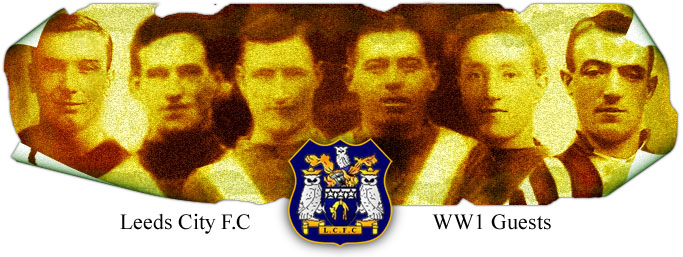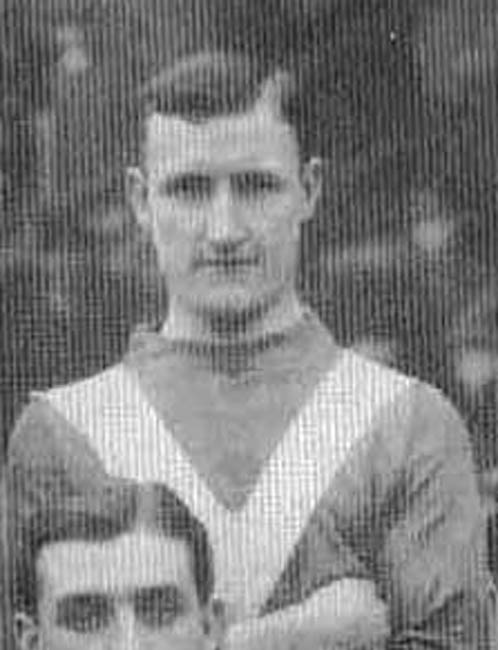

Hampson: William (Billy)
1916-1919 (Leeds City War-time Guest Player Details)
Full Back
Born: Radcliffe: 26-08-1884
Debut: v Leicester Fosse (a): 09-12-1916
Height & Weight: Unknown
Billy Hampson, the oldest Cup Finalist of the 20th Century, took over at Elland Road from Dick Ray. Don Revie apart, Billy Hampson
held the post of Leeds United manager for longer than anyone, twelve years. However, with that period spanning the Second World War,
he was only in charge for five seasons of official peacetime football. Born in Radcliffe on 26 August 1882, he was a late developer as a
footballer. Billy Hampson was the brother of Walker Hampson and Tommy Hampson, who both also played for Leeds City as guests in
the War Years. The three brothers played in the same team on the three occasions that Walker Hampson played for City in the Subsidiary
Competition in April 1918. He had already played at full back for Rochdale, Bury and Norwich City, when, as a 31 year old, Newcastle
United signed him for £1,250 in January 1914. Later that year, war broke out and Newcastle closed St James' Park for the duration.
Hampson wanted to carry on playing, and joined Leeds City as a guest player during the war. He was a regular, turning out in ninety-one
matches between December 1916 and April 1919, helping them to win the unofficial title of League Champions in 1918. He returned to
Newcastle after the war aged 37, but had to play second fiddle to the even older Tyneside legend Bill McCracken, who is credited with
getting the offside law changed in the 1920's. McCracken became so adept at catching forwards offside that it forced a change in the
rules of the game. Hampson soldiered on at Newcastle and when McCracken took over as Hull City manager in early 1923, he finally
secured a regular spot in the first team. He went on to become the oldest FA Cup finalist ever when he turned out in the No. 2 shirt in the
1924 Final. Newcastle beat Aston Villa 2-0 - at forty-one years and eight months when he played right back for Newcastle, (but Billy
Meredith became the oldest man to play in the FA Cup when, at the age of forty-nine years and eight months, he took the field for
Manchester City against the Geordies in the semi finals). He later became the Manager of Leeds United. He started his football career
in his native Lancashire with Woolfold Wesleyans, Ramsbottom and then Rochdale Town. He joined First Division Bury in May 1906 and
played twice for them in 1907-08 before leaving for Non-League Norwich City in 1908. He joined First Division Newcastle United in
January 1914 for £1,250 and had made seventeen League appearances and one game in the F.A. Cup for them before the outbreak of
WW1. As the Magpies refused to participate in any War-time games their players guested with other clubs and the talented Full Back
guested with Leeds on a regular basis from December 1916 until the recommencement of Football League fixtures in 1919-20. He was
part of the successful Leeds City team of 1917-18, along with his younger brother Tommy which beat Stoke in the play-off finals to claim
the unofficial title of League Champions. He returned to St Jamesí Park on the recommencement of the Football League after the end of
WW1 and many thought his best years were behind him at thirty-seven and he even lost his first team spot to the even older Billy
McCracken but he fought back to regain his place in the team when McCracken left to manage Hull City in 1923. Hampson became the
oldest player to appear in an F.A. Cup Final at forty-one years and eight months when Newcastle United beat Aston Villa 2-0 in the 1924
F.A. Cup Final. He remained at Newcastle United for another three years, until signing for Second Division South Shields in September
1927. He played one hundred and forty-six League games and scored just once, from a penalty on 27th October 1923 as the Magpies
beat Middlesbrough in a First Division by 3 goals to 2. He also made ten F.A. Cup appearances in his second spell with Newcastle a
total of one hundred and seventy-four games. He played twenty-five League games and one F.A. Cup game for South Shields before he
retired in March 1930 at the age of forty-seven. He was back in the game instantly as he took over as Manager of lowly Carlisle United
later that month. His time at the club was largely unsuccessful as the team finished fifteenth and conceded one hundred and one goals in
his first campaign. However, he did unearth two footballing gems in Bill Shankly and Bob Batey, who went on to have excellent reputations.
Batey joining Leeds United after both had found success with Preston North End. He left the club in May, 1933 and had a short stint in
charge of Ashington back in the north-east before taking over from Dick Ray as Manager of Leeds United in March 1935. They finished
eighteenth at the end of his first season in charge. Hampson felt the team need experienced players which prompted him to sign former
England internationals, goalkeeper Albert McInroy and forward George Brown, in the summer. There was a slight improvement when the
team finished eleventh and they consolidated their First Division status in the few years before World War Two. They did, however, lack
consistency and avoided relegation by just two points in 1936-37. Hampson began to develop a lot of young players, leading to Leeds'
only Central League win that same season. He was also known for scouting Ireland for young players, such as David Cochrane from
Portadown, Bobby Browne (Derry City) and Jim Twomey (Newry Town), all of whom became full Internationals. His squad generally
consisted of both youth and experience but the team went into decline in the War years and when football officially restarted after the war,
in 1946-47, these players were well past their best. Hampson stood by his pre-war squad and his gesture of loyalty proved to be his and
Unitedís downfall. Leeds had their worst season ever, collecting only one point from their away games and just six victories in the whole
season. They finished bottom with eighteen points, fifteen points away from safety. At the beginning of April 1947, with Leeds already as
good as down, Hampson was replaced by former United player Willis Edwards and demoted to chief scout. He only remained in that role
until the following October before going his own way and later working as a coach for the Northumberland Schools FA. In total Hampson
held the post of United Manager for twelve years. However, as that period spanned the Second World War, he was only in charge for five
seasons in the Football League. With an ill-starred combination of youth and experience, Leeds plunged back into the second division.
Some players felt he did not need to fall on his sword. Rookie full back Jimmy Dunn, whom Hampson had brought to Leeds from Scotland,
said, 'He seemed a wonderful chap. It was a surprise when he went so quickly.' He had struggled with the financial difficulties that United
(and Leeds City before them) had faced throughout their history and did well to maintain First Division status as long as he did. Leeds did
not have the resources to compete with the top clubs for the best talent and were usually forced to sell their better players, such as Wilf
Copping (who left for Highbury before Hampson's time, but returned to Elland Road before the war) and right back Bert Sproston, whom
he sold to Tottenham for a near record £9,500 fee in June 1938. The best that could be hoped for in the circumstances was to discover
enough raw young talent to be developed for sale to the bigger clubs and to muddle by as best they could. Hampson managed that well
enough and built up a loyal and dedicated set of players, who respected and liked him. But in the end, misplaced loyalty to his proven
players led to his downfall.He died on 24th February 1966 at Congleton in Cheshire.
| War-time Guest Appearances | Goals |
| |
| Principal Tournament 72 | 1 |
| Subsidiary Tournament 17 | 0 |
| Play-off Finals 2 | 0 |
| Total 91 | 1 |